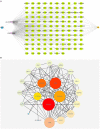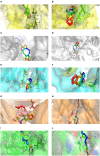Exploring the Anti-inflammatory Effects of Protopine Total Alkaloids of Macleaya Cordata (Willd.) R. Br
- PMID: 35865876
- PMCID: PMC9294607
- DOI: 10.3389/fvets.2022.935201
Exploring the Anti-inflammatory Effects of Protopine Total Alkaloids of Macleaya Cordata (Willd.) R. Br
Abstract
Macleaya cordata (Willd). R. Br. is a Chinese medicinal plant commonly used externally to treat inflammatory-related diseases such as arthritis, sores, and carbuncles. This study aimed to evaluate the anti-inflammatory activity of protopine total alkaloids (MPTAs) in Macleaya cordata (Willd.) R. Br. in vivo tests in rats with acute inflammation showed that MPTA (2.54 and 5.08 mg/kg) showed significant anti-inflammatory activity 6 h after carrageenan injection. Similarly, MPTA (3.67 and 7.33 mg/kg) showed significant anti-inflammatory activity in the mouse ear swelling test. In addition, the potential mechanisms of the anti-inflammatory effects of MPTA were explored based on network pharmacology and molecular docking. The two main active components of MPTA, protopine and allocryptopine, were identified, and the potential targets and signaling pathways of MPTA's anti-inflammatory effects were initially revealed using tools and databases (such as SwissTargetPrediction, GeneCards, and STRING) combined with molecular docking results. This study provides the basis for the application of MPTA as an anti-inflammatory agent.
Keywords: Macleaya cordata (Willd.) R. Br.; acute inflammation; anti-inflammatory; molecular docking; network pharmacology; protopine total alkaloids.
Copyright © 2022 Dong, Wang, Tang, Li, Jiang, Yang and Zeng.
Conflict of interest statement
Z-sT and C-hL were employed by the Hunan MICOLTA Biological Resources Co., Ltd. The remaining authors declare that the research was conducted in the absence of any commercial or financial relationships that could be construed as a potential conflict of interest.
Figures







Similar articles
-
Acute, chronic, and genotoxic studies on the protopine total alkaloids of the Macleaya cordata (willd.) R. Br. in rodents.Front Pharmacol. 2022 Sep 28;13:987800. doi: 10.3389/fphar.2022.987800. eCollection 2022. Front Pharmacol. 2022. PMID: 36249819 Free PMC article.
-
Macleaya cordata protopine total alkaloids as potential treatment for diarrhoea: Mechanistic insights and target identification.Res Vet Sci. 2025 Jun;189:105633. doi: 10.1016/j.rvsc.2025.105633. Epub 2025 Apr 1. Res Vet Sci. 2025. PMID: 40184723
-
Potential Toxicity Evaluation of Protopine in Macleaya cordata (Willd.) R. Br.-A Bioactivity Guided Approach.Front Vet Sci. 2021 Nov 25;8:752767. doi: 10.3389/fvets.2021.752767. eCollection 2021. Front Vet Sci. 2021. PMID: 34901245 Free PMC article.
-
Analysis of the Impact of Isoquinoline Alkaloids, Derived from Macleaya cordata Extract, on the Development and Innate Immune Response in Swine and Poultry.Biomed Res Int. 2016;2016:1352146. doi: 10.1155/2016/1352146. Epub 2016 Nov 30. Biomed Res Int. 2016. PMID: 28042566 Free PMC article. Review.
-
Medicinal plants of the genus Macleaya (Macleaya cordata, Macleaya microcarpa): A review of their phytochemistry, pharmacology, and toxicology.Phytother Res. 2018 Jan;32(1):19-48. doi: 10.1002/ptr.5952. Epub 2017 Nov 12. Phytother Res. 2018. PMID: 29130543 Review.
Cited by
-
6-Methoxydihydrosanguinarine Suppresses the Proliferation of Non-small Cell Lung Cancer Cells through Elevation of ROS and Activation of IRE1/JNK Signaling.Cell Biochem Biophys. 2025 Aug 29. doi: 10.1007/s12013-025-01850-y. Online ahead of print. Cell Biochem Biophys. 2025. PMID: 40879881 No abstract available.
-
Residue of allocryptopine and protopine in tissues and eggs of laying hens using ultra-high performance liquid chromatography-tandem mass spectrometry.Poult Sci. 2025 Jun;104(6):105124. doi: 10.1016/j.psj.2025.105124. Epub 2025 Apr 3. Poult Sci. 2025. PMID: 40203616 Free PMC article.
-
Protopine-Type Alkaloids Alleviate Lipopolysaccharide-Induced Intestinal Inflammation and Modulate the Gut Microbiota in Mice.Animals (Basel). 2024 Aug 5;14(15):2273. doi: 10.3390/ani14152273. Animals (Basel). 2024. PMID: 39123799 Free PMC article.
-
Herbgenomics meets Papaveraceae: a promising -omics perspective on medicinal plant research.Brief Funct Genomics. 2024 Sep 27;23(5):579-594. doi: 10.1093/bfgp/elad050. Brief Funct Genomics. 2024. PMID: 37952099 Free PMC article. Review.
-
Acute, chronic, and genotoxic studies on the protopine total alkaloids of the Macleaya cordata (willd.) R. Br. in rodents.Front Pharmacol. 2022 Sep 28;13:987800. doi: 10.3389/fphar.2022.987800. eCollection 2022. Front Pharmacol. 2022. PMID: 36249819 Free PMC article.
References
-
- Chen T, Shang Z. Commentary on Supplement to Medica. Hefei: Anhui Science and Technology Press; (2002).
-
- Ali I, Li J, Cui L, Zhao H, He Q, Wang D. Efficient extraction and purification of benzo[c]phenanthridine alkaloids from Macleaya cordata (Willd) R. Br by combination of ultrahigh pressure extraction and pH-zone-refining counter-current chromatography with anti-breast cancer activity in vitro. Phytochem Anal. (2021) 32:423–32. 10.1002/pca.2990 - DOI - PubMed
LinkOut - more resources
Full Text Sources

